[ Table of Contents ] [ Prev ] [ Chapter Overview ] [ Next ] [ Glossary/Index ]
Program units can be "connected" or "snapped together" using three
kinds of relationships:
- Withing Relationships
- Parent/Child Relationships
- Nesting Relationships
In the following table the first three rows depict withing relationships (based on with clauses), the fourth row depicts two
kinds of parent/child relationships, and the last two rows depict nesting relationships.
You have already seen examples of withing relationships (like those depicted in the first
row of the table), and you will see many more throughout this volume. You have not yet
seen examples of parent/child relationships or nesting relationships, but both kinds of
examples appear in this chapter.
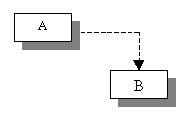
|
Withing-1
Any body of a library unit can "with
in" any other library unit.
(e.g., procedure A withs in procedure B) |
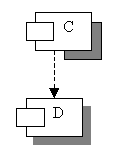
|
Withing-2
The declaration of any package
can "with in" any other library unit.
(e.g., the declaration of package C withs in package D) |
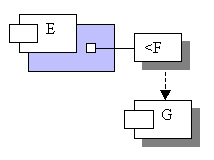
|
Withing-3
Any separately compiled subunit body can
"with in" any library unit.
(e.g., function F, which is logically nested in package E, withs in package G) |
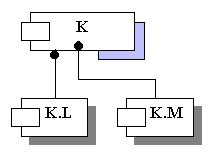
|
Parent/Child
Given a library package, new child units
(library packages or library subprograms) can be declared, either as public or private
children.
(e.g., package K.L is a public
child of package K and package K.M is a private child of K, the parent unit) |
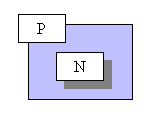
|
Nesting-1-step
Any kind of program unit can be a nested unit,
one that is implemented or declared and implemented in the body of another unit.
(e.g., procedure N is nested in procedure P) |
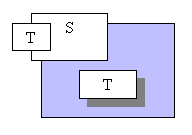
|
Nesting-2-steps
Any kind of program unit can be nested in a package by 1) being declared in the
package's declaration and 2) implemented in the same package's body.
(e.g., procedure T is declared in the declaration of package S and implemented in the
body of S) |
Collaborating Program Units
As we have said, a program can be viewed as a collection of program units connected together (in the
ways shown above) and collaborating together to perform useful activities. All six of the
connecting styles tabulated above are illustrated in the examples of this chapter. The
most common way of connecting two units is the "Withing-1" method shown in the
first row of the table, where the body of one client
unit "withs in" another server unit
-- always a library unit. The dashed arrow used to represent withing relationships was
chosen because the same graphic symbol
is used for a similar purpose in the UML notation
[Fowler97], to represent the dependency relationship
of one unit upon another.
Related Topics
[ Back to top of page ] [ Prev ] [ Next ]





